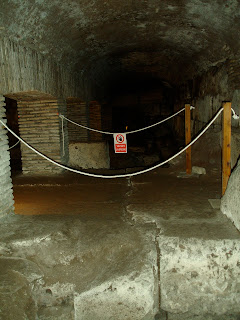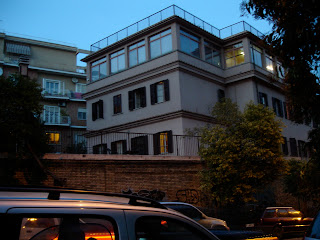Since you've now seen the ancient center of Rome, we'll take you on our walking tour around it.
 |
Santa Maria di Loreto
(aka Mary in a papoose).
Click to enlarge. |
On the north side of the Forum of Trajan (one of the Imperial Fora) are two small round churches, both of which we decided to visit while we were in the area. One of them is Santa Maria di Loreto, which included a chapel with a fairly modern statue of what appeared to be Mary in a papoose. We have no idea what the meaning of this statue is (nor can we find anything about it on-line), but Lisa says its one of the coolest thing she saw in Rome.
 |
| Circus Maximus. |
South of the Palatine (the posh place to live in Republican Rome, then the area of the imperial palace complex in the empire), we could see the Circus Maximus, the site of chariot races in ancient Rome. When I lived in Rome eight years ago, it was just a large green park for joggers and dog-walkers, but today it appears to have been taken over by the Carabinieri (Italy's national police force) for some reason. They had helicopters, planes, tanks, and trucks on display there but I have no idea why.
 |
| We told the truth, so we kept our hands! |
 |
The inside of S. Maria in
Cosmedin was equally
worth seeing! |
We did two other things of interest near the Palatine and the Circus Maximus. First, we visited the Bocca della Verità ("the Mouth of Truth"), also immortalized in Roman Holiday. It's a large stone face (probably a medieval drain-spout) in the porch of the church of S. Maria in Cosmedin. According to legend, you put your hand in the mouth, someone asks you a question, and if you're lying it bites off your hand. There were many Japanese tourists there when we stopped by and I also don't remember there being a security guard and metal gates to form lines when I went eight years ago. Still, we got our picture there.
 |
| San Nicolas in Carcere. |
 |
| Sanctuary, San Nicolas in Carcere. |
 |
| Substructure of ancient temples. |
The other thing we did was to go inside the church of San Nicolas in Carcere. This is located between the Bocca della Verità and the Capitoline (the site of the largest and oldest temple in Rome). It's built on top of an ancient Roman temple and in fact, you can see from the outside how the columns of the temple were incorporated into the exterior wall. Inside, it's a perfectly normal Roman church, but you can go down into the crypt for two euros a person. I initially didn't want to do this (I thought there were more interesting things to see elsewhere), but Lisa suggested we ask the care-taker if we could go down. He said we could (although he seemed a little put out by it), he opened the gate, and he led us (and three other Italians) down. At first, it seemed like a small, normal crypt, without much to see, and it was rather disappointing. Then, the caretaker disappeared through another door, marked with a sign that said, "If you want to go past this point, you must pay 5 euros." We thought, great, another scam to get us to part with more money. However, everyone followed the caretaker and he didn't ask for more money. Behind the door, we were led into an excavated area under the church where we could see the actual foundations of the second-century BC temple the church is built on as well as the two temples on either side of it. The guide led us all around the exterior walls of the church, showing us the foundations, the columns, and other architectural fragments from the ancient temples. There were also maps and descriptions set up at various places, which helped immensely since he only spoke in Italian, making it hard for us to follow his description. Regardless, I thought it was one of the coolest things we did in Rome, so thanks, Lisa, for insisting on going down!
 |
Original Roman pavement in the crypt of San Nicolas. The
ground level was much lower in ancient times. |
 |
| Pyramid of Cestius. |
 |
| Cat, directions to graves. |
Further south from that, we walked to the Pyramid of Cestius, the grave of a late first-century BC aristocrat who really like Egypt and wanted his grave to be in the shape of a big pyramid. The real reason I wanted to go there, though, is because it's connected to the Non-Catholic Cemetery in Rome which is another cat sanctuary (I wanted to be sure Lisa got her fill of cats!
Lisa thinks this is because he fears she will adopt a French one if he doesn't find others for her to visit.). Unfortunately for her, there weren't as many cats there as in Largo Argentina, but fortunately for us, we were able to see the graves of the poets Shelley (who, unfortunately for him, died at sea off the coast of Italy) and Keats (who, also unfortunately, died of tuberculosis in Rome).
 |
| Pottery on the Monte Testaccio. |
On the way back up into Trastevere for dinner, we passed Monte Testaccio, which was formed between the first century BC and the third century AD entirely out of broken pottery. It stands near the Tiber River at the point where 70-liter clay jugs of imported olive oil were unloaded from ships, poured into smaller containers, then stored. Once the large 70-liter jugs were emptied, they were broken down and dumped in the carefully organized trash pile of Monte Testaccio which is 115 ft high and contains an estimated 53 million olive oil jugs. That means that in the third century AD, Rome was importing about 7.5 million liters of olive oil a year! Also, according to Wikipedia, in the 19th century, caves were dug into the hill in order to keep wine cool during the hot Roman summers. The porous structure of the hill, made up as it is of pottery sherds, created a kind of ventilation system that kept the interior cool. It kind of makes you wonder what people two thousand years from now will be doing with our garbage heaps, doesn't it?
































































